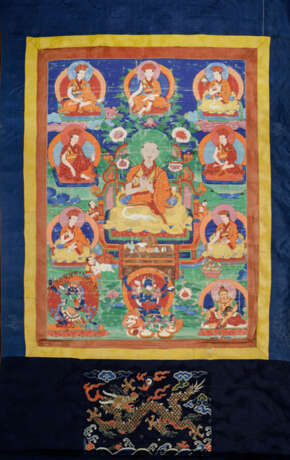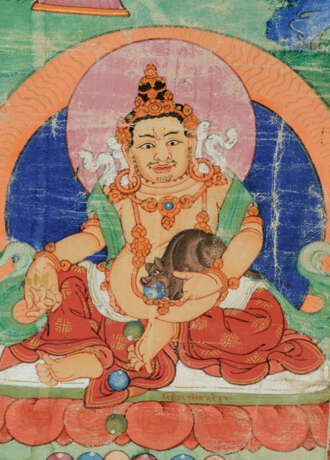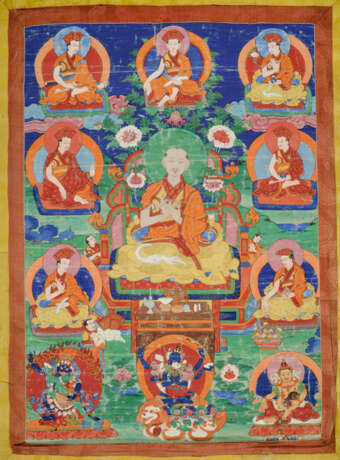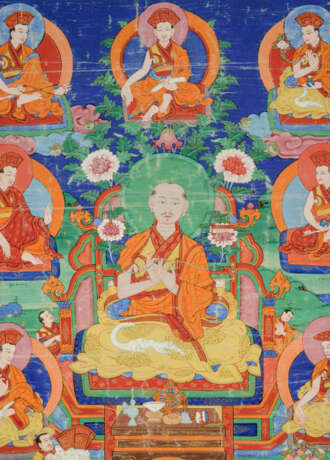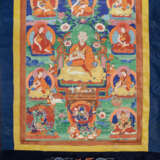ID 83513
Lot 113 | Linienthangka der Drukpa-Tradition
Estimate value
€ 2 000 – 3 000
Der hohe Lama im Zentrum der Malerei ist inschriftlich als Jignam Kunga Kapdak Dodin Lapsang Paygai Shap benannt. Er sitzt auf auf mehreren Kissen auf einem ausladenden Thron mit reicher Ornamentik. Vor ihm steht ein altarähnliches Tischchen auf dem sich verschiedene rituelle Utensilien befinden. Der Geistliche trägt die traditionelle Mönchskleidung mit Mönchsweste, und einen orangefarbenen Flickenmantel, symbolhaft für seine Besitzlosigkeit. Desweiteren umgibt ihn ein von den Schultern abgestreifter gelbfarbener, golddurchwirkter Mantel, wie Ihn die Gelehrten tragen. In beiden Händen hält der Lama links und rechts einen Lotuszweig mit seinen Attributen: Schwert der Erkenntnis, und Buch der Weisheit - Prajnaparamita. Er ist ohne den traditionellen Hut, wie ihn die Geistlichen dieser Schule tragen, dargestellt. Dieser Hut wird ihm auf einem weißen Tuch, vermutlich von einem seiner Schüler, die sich neben seinem Thronsessel befinden, dargereicht. Weitere Geistliche dieser Linie, die der Kagyü-Tradition untergeordnet ist, sind über die Bildfläche verteilt. Der in sich der Mitte oben befindende Lama ist inschriftlich als Pasang Wangpo benannt. Bei den beiden links und rechts dargestellten Persönlichkeiten sind die Inschriften nicht mehr identifizierbar. Darunter links und rechts erscheinen Lopsang Mepang Wangpo und Mepang Chöky Wangchuk. Darunter erscheinen links und rechts Mepang Sonam Dukgal (?) und Nawang Gelik Dukgay. Die Namen der Lamas sind unsicher, da die Inschriften teilweise ausgebrochen sind. Im unteren Bereich der Landschaft erscheinen von links nach rechts: Der blaufarbene Vajrapani mit seiner Partnerin, von grüner Körperfarbe. In der Mitte ist eine seltene tantrische Darstellung des Dorje Chang mit drei Köpfen und sechs Armen dargestellt, seine weißfarbene Weisheitspartnerin umfangend. In seinen oberen Händen hält Dorje Chang Pfeil und Bogen, in seinen mittleren Händen links eine Kapala und rechts zeigt er eine Mudra (unklar). Das untere Händepaar hält Glocke und Vajra. Seine Partnerin hat als Attribut in ihrer linken Hand eine Kapala, und in der rechten, sich hinter dem Rücken Ihres Partners befindlichen Hand, den tantrischen Stab khatvanga. Beide Gottheiten sitzen auf einem Lotos über einem weißen Schneelöwen. In der rechten unteren Ecke befindet sich der Reichtumsgott Jambhala. Tempera und Gold auf Baumwollgewebe, originale Seidensatin-Einfassung mit Goldbrokateinsatz. Traditionelles seidenes Schutztuch, Rückseite: Weihesilben in zinnoberroter Farbe: om a hum.
Provenienz: Aus süddeutschem Industriellenbesitz, 1969 bei Schoettle Ostasiatica erworben - Altersspuren
77 x 53/140 x 80 cm
| Address of auction |
LOFT Salzburg Müllner Hauptstrasse 1 5020 Salzburg Austria | ||||||||||||||
|---|---|---|---|---|---|---|---|---|---|---|---|---|---|---|---|
| Preview |
| ||||||||||||||
| Phone | +43 662 243045 | ||||||||||||||
| Conditions of purchase | Conditions of purchase | ||||||||||||||
| Shipping |
Postal service Courier service pickup by yourself | ||||||||||||||
| Payment methods |
Wire Transfer | ||||||||||||||
| Business hours | Business hours
|
